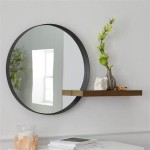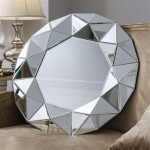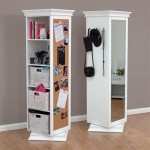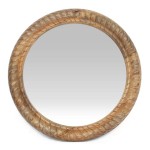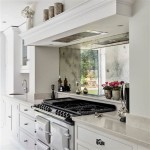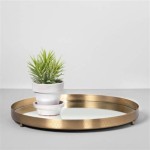Are Pivot Mirrors Good? A Comprehensive Look at Their Benefits and Drawbacks
Pivot mirrors, also known as swinging or swivel mirrors, offer a unique blend of functionality and style. Their ability to rotate and adjust provides a versatile viewing experience, making them a popular choice for bathrooms, bedrooms, and dressing areas. This article delves into the advantages and disadvantages of pivot mirrors to help consumers make an informed decision.
Advantages of Pivot Mirrors
Pivot mirrors offer several key benefits that contribute to their popularity:
1. Enhanced Viewing Angles: The primary advantage of a pivot mirror is its adjustable nature. Users can easily tilt and rotate the mirror to achieve the perfect viewing angle, eliminating blind spots and providing a more comprehensive reflection.
2. Customization and Flexibility: Pivot mirrors cater to individual needs and preferences. Whether applying makeup, styling hair, or checking an outfit, the adjustable angle allows for precise viewing, enhancing convenience and comfort.
3. Space Optimization: In smaller spaces, pivot mirrors can be particularly useful. Their adjustable nature allows users to maximize the mirror's functionality without requiring additional wall space. The mirror can be tucked away when not in use, optimizing space efficiency.
4. Accessibility for Multiple Users: In shared bathrooms or bedrooms, a pivot mirror can accommodate various heights and preferences. The adjustable angle ensures that everyone can easily use the mirror without straining or compromising their view.
5. Aesthetically Pleasing: Pivot mirrors often add a touch of elegance and sophistication to a space. Their sleek design and adjustable mechanism can complement various interior styles, from modern to traditional.
6. Improved Lighting Control: By adjusting the angle of a pivot mirror, users can optimize the reflection of available light sources. This can be especially helpful in areas with limited natural light, allowing for better illumination and visibility.
Disadvantages of Pivot Mirrors
While pivot mirrors offer numerous advantages, it is important to consider potential drawbacks:
1. Stability Concerns: The pivoting mechanism, though designed for movement, can sometimes become loose over time. This can lead to instability and wobble, affecting the mirror's usability and potentially posing a safety hazard.
2. Limited Rotation Range: Some pivot mirrors have a restricted rotation range, potentially limiting their adjustability and overall effectiveness. It's crucial to check the mirror's specifications to ensure it meets the desired range of motion.
3. Potential for Damage: The moving parts of a pivot mirror can be susceptible to damage if handled roughly. Frequent adjustments or excessive force can wear down the mechanism, reducing its lifespan.
Installation Challenges
Installing a pivot mirror can present some challenges:
1. Precise Mounting Required: Proper installation is crucial for the stability and functionality of a pivot mirror. Inaccurate mounting can lead to wobbling, limited movement, or even damage to the wall.
2. Specialized Hardware: Pivot mirrors typically require specific hardware for installation, which may not be readily available. Ensuring the correct hardware is used is vital for a secure and stable mounting.
Cleaning and Maintenance
Maintaining a pivot mirror requires attention to its specific design:
1. Cleaning the Pivoting Mechanism: Dust and debris can accumulate in the pivoting mechanism, hindering its smooth operation. Regular cleaning is necessary to maintain the mirror's functionality and prevent damage.
2. Gentle Handling: When cleaning or adjusting the mirror, it's important to handle it gently to avoid damaging the pivoting mechanism or the mirror surface itself.
Cost Considerations
Understanding the price range of pivot mirrors is essential for budgeting:
1. Price Variations: Pivot mirrors are available at various price points, depending on size, materials, and features. It's important to research different options to find a mirror that fits within budget constraints.
2. Long-Term Value: While some pivot mirrors can be more expensive than traditional fixed mirrors, their added functionality and potential for space optimization can provide long-term value.
Choosing the Right Pivot Mirror
Selecting the appropriate pivot mirror requires careful consideration:
1. Size and Shape: The dimensions and shape of the mirror should be chosen based on the space available and the intended use. Consider factors such as wall space, viewing distance, and overall aesthetic preferences.
2. Material and Finish: Pivot mirrors come in various materials and finishes, including chrome, brushed nickel, and brass. Choosing a finish that complements the existing décor is essential for a cohesive look.
3. Mounting Style: Different pivot mirrors have different mounting styles, such as wall-mounted or cabinet-mounted. Selecting the appropriate mounting style depends on the installation location and desired aesthetic.

Rock Your Reno With These 11 Bathroom Mirror Ideas

Metal Frame Pivot Round Wall Mirror 24 West Elm

Metal Frame Pivot Wall Mirror Rectangle West Elm

Moon Mirror 20 X30 Brushed Gold Pivot For Bathroom Brass Metal Frame Mirrors Wall Rectangle Titling Vanity With Rounded Corner Com

Buy Metal Frame Pivot Mirror Landscape Now West Elm Uae

Industrial Rivet Pivot Mirrors Design Ideas

Black Tilting Pivot Rectangle Bathroom Mirrors Mirror Frame

West Slope Rounded Rectangle Pivot Mirror Rejuvenation

Tehome Woodvale 30 In W X 40 H Extra Large Pivot Rectangular Metal Framed Wall Mounted Bathroom Vanity Mirror Chrome Gc 00557 The Home Depot

Tehome Luecinda 20 In W X 30 H Medium Pivot Oval Metal Framed Beveled Wall Mounted Bathroom Vanity Mirror Matt Black Gc 00197 The Home Depot

